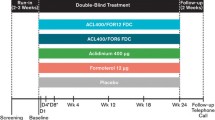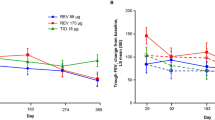Abstract
Purpose
Aerosol furosemide may be an option to treat refractory dyspnea, though doses, methods of delivery, and outcomes have been variable. We hypothesized that controlled delivery of high dose aerosol furosemide would reduce variability of dyspnea relief in patients with underlying pulmonary disease.
Methods
Seventeen patients with chronic exertional dyspnea were recruited. Patients rated recently recalled breathing discomfort on a numerical rating scale (NRS) and the multidimensional dyspnea profile (MDP). They then performed graded exercise using an arm-ergometer. The NRS was completed following each exercise grade, and the MDP was repeated after a pre-defined dyspnea threshold was reached. During separate visits, patients received either aerosol saline or 80 mg of aerosol furosemide in a randomized, double-blind, crossover design. After treatment, graded exercise to the pre-treatment level was repeated, followed by completion of the NRS and MDP. Treatment effect was defined as the difference between pre- and post-treatment NRS at end exercise, expressed in absolute terms as % Full Scale. “Responders” were defined as those showing treatment effect ≥ 20% of full scale.
Results
Final analysis included 15 patients. Neither treatment produced a statistically significant change in NRS and there was no significant difference between treatments (p = 0.45). There were four “responders” and one patient whose dyspnea worsened with furosemide; two patients were responders with saline, of whom one also responded to furosemide. No adverse events were reported.
Conclusions
High dose controlled delivery aerosol furosemide was not statistically different from saline placebo at reducing exercise-induced dyspnea. However, a clinically meaningful improvement was noted in some patients.



Similar content being viewed by others
References
Higginson I, McCarthy M (1989) Measuring symptoms in terminal cancer: are pain and dyspnoea controlled? J R Soc Med 82(5):264–267
Desbiens NA et al (1997) The relationship of nausea and dyspnea to pain in seriously ill patients. Pain 71(2):149–156
Bjoraker JA et al (1998) Prognostic significance of histopathologic subsets in idiopathic pulmonary fibrosis. Am J Respir Crit Care Med 157(1):199–203
Swigris JJ et al (2005) Health-related quality of life in patients with idiopathic pulmonary fibrosis: a systematic review. Thorax 60(7):588–594
Ryerson CJ et al (2011) Depression and functional status are strongly associated with dyspnea in interstitial lung disease. Chest 139(3):609–616
Miravitlles M et al (2014) Observational study to characterise 24-hour COPD symptoms and their relationship with patient-reported outcomes: results from the ASSESS study. Respir Res 15:122
Zhao I, Yates P (2008) Non-pharmacological interventions for breathlessness management in patients with lung cancer: a systematic review. Palliat Med 22(6):693–701
Bausewein C (2008) Non-pharmacological interventions for breathlessness in advanced stages of malignant and non-malignant diseases. Cochrane Database Syst Rev 2:CD005623.
Chowienczyk S et al (2016) Association of descriptors of breathlessness with diagnosis and self-reported severity of breathlessness in patients with advanced chronic obstructive pulmonary disease or cancer. J Pain Symptom Manage 52(2):259–264
Smith J et al (2009) Qualitative aspects of breathlessness in health and disease. Thorax 64(8):713–718
Morelot-Panzini C et al (2016) Real-life assessment of the multidimensional nature of dyspnoea in COPD outpatients. Eur Respir J 47(6):1668–1679
Hill L, Flack M (1908) The effect of excess of carbon dioxide and of want of oxygen upon the respiration and the circulation. J Physiol 37(2):77–111
Flume PA et al (1996) Relief of the 'air hunger' of breathholding. A role for pulmonary stretch receptors. Respir Physiol 103(3):221–232
Manning HL et al (1992) Reduced tidal volume increases ‘air hunger’ at fixed PCO2 in ventilated quadriplegics. Respir Physiol 90(1):19–30
Sudo T, Hayashi F, Nishino T (2000) Responses of tracheobronchial receptors to inhaled furosemide in anesthetized rats. Am J Respir Crit Care Med 162(3Pt1):971–975
Yu J, Wang YF, Zhang JW (1985) Structure of slowly adapting pulmonary stretch receptors in the lung periphery. J Appl Physiol 95(1):385–393
Matsumoto S et al (1998) Excitatory mechanism of veratridine on slowly adapting pulmonary stretch receptors in anesthetized rabbits. Life Sci 63(16):1431–1437
Waskiw-Ford M et al (2018) Effect of inhaled nebulized furosemide (40 and 120 mg) on breathlessness during exercise in the presence of external thoracic restriction in healthy men. Front Physiol 9:86
Morelot-Panzini C et al (2018) Aerosol furosemide for dyspnea: controlled delivery does not improve effectiveness. Respir Physiol Neurobiol 247:146–155
Banzett RB et al (2018) Aerosol furosemide for dyspnea: high-dose controlled delivery does not improve effectiveness. Respir Physiol Neurobiol 247:24–30
Shimoyama N, Shimoyama M (2002) Nebulized furosemide as a novel treatment for dyspnea in terminal cancer patients. J Pain Symptom Manage 23(1):73–76
Kohara H et al (2003) Effect of nebulized furosemide in terminally ill cancer patients with dyspnea. J Pain Symptom Manage 26(4):962–967
Moosavi SH et al (2007) Effect of inhaled furosemide on air hunger induced in healthy humans. Respir Physiol Neurobiol 156(1):1–8
Nishino T et al (2000) Inhaled furosemide greatly alleviates the sensation of experimentally induced dyspnea. Am J Respir Crit Care Med 161(6):1963–1967
Laveneziana P et al (2008) Inhaled furosemide does not alleviate respiratory effort during flow-limited exercise in healthy subjects. Pulm Pharmacol Ther 21(1):196–200
Stone P et al (2002) Re: nebulized furosemide for dyspnea in terminal cancer patients. J Pain Symptom Manage 24(3):274–275 (author reply 275–276)
Ong KC et al (2004) Effects of inhaled furosemide on exertional dyspnea in chronic obstructive pulmonary disease. Am J Respir Crit Care Med 169(9):1028–1033
Wilcock A et al (2008) Randomised, placebo controlled trial of nebulised furosemide for breathlessness in patients with cancer. Thorax 63(10):872–875
Jensen D et al (2008) Mechanisms of dyspnoea relief and improved exercise endurance after furosemide inhalation in COPD. Thorax 63(7):606–613
Panahi Y et al (2008) Furosemide inhalation in dyspnea of mustard gas-exposed patients: a triple-blind randomized study. Inhal Toxicol 20(9):873–877
Grogono JC et al (2018) Inhaled furosemide for relief of air hunger versus sense of breathing effort: a randomized controlled trial. Respir Res 19(1):181
Robuschi M et al (1989) Inhaled frusemide is highly effective in preventing ultrasonically nebulised water bronchoconstriction. Pulm Pharmacol 1(4):187–191
Newhouse MT, Dolovich MB (1986) Control of asthma by aerosols. N Engl J Med 315(14):870–874
Banzett RB et al (2015) Multidimensional Dyspnea Profile: an instrument for clinical and laboratory research. Eur Respir J 45(6):1681–1691
Johnson MJ et al (2013) Clinically important differences in the intensity of chronic refractory breathlessness. J Pain Symptom Manage 46(6):957–963
Bianco S et al (1988) Prevention of exercise-induced bronchoconstriction by inhaled frusemide. Lancet 2(8605):252–255
Ono Y et al (1997) Furosemide given by inhalation ameliorates acute exacerbation of asthma. J Asthma 34(4):283–289
Lansing RW et al (1998) Tidal volume perception in a C1–C2 tetraplegic subject is blocked by airway anesthesia. J Spinal Cord Med 21(2):137–141
O’Donnell CR et al (2017) The effect of aerosol saline on laboratory-induced dyspnea. Lung 195(1):37–42
Noseda A et al (1992) Perceived effect on shortness of breath of an acute inhalation of saline or terbutaline: variability and sensitivity of a visual analogue scale in patients with asthma or COPD. Eur Respir J 5(9):1043–1053
Poole PJ et al (1998) The effects of nebulised isotonic saline and terbutaline on breathlessness in severe chronic obstructive pulmonary disease (COPD). Aust N Z J Med 28(3):322–326
Mahler DA et al (2009) Endogenous opioids modify dyspnoea during treadmill exercise in patients with COPD. Eur Respir J 33(4):771–777
Price DD, Finniss DG, Benedetti F (2008) A comprehensive review of the placebo effect: recent advances and current thought. Annu Rev Psychol 59:565–590
Khan SY, O’Driscoll BR (2004) Is nebulized saline a placebo in COPD? BMC Pulm Med 4:9
Newton PJ et al (2008) Nebulized furosemide for the management of dyspnea: does the evidence support its use? J Pain Symptom Manage 36(4):424–441
Acknowledgements
The authors would like to thank the participants who made this study possible, as well as the staff of the Clinical Research Center at the Beth Israel Deaconess Medical Center. Special thanks to Joe Brain and Jim Butler for their advice on aerosol delivery, and to Robert Lansing for his critical input on experimental design and manuscript preparation.
Funding
Supported by NIH grant NR12009.
Author information
Authors and Affiliations
Corresponding author
Ethics declarations
Conflicts of interest
The authors declare that they have no relevant conflicts of interest.
Additional information
Publisher's Note
Springer Nature remains neutral with regard to jurisdictional claims in published maps and institutional affiliations.
Electronic supplementary material
Below is the link to the electronic supplementary material.
Rights and permissions
About this article
Cite this article
Hallowell, R.W., Schwartzstein, R., O’Donnell, C.R. et al. Controlled Delivery of 80 mg Aerosol Furosemide Does Not Achieve Consistent Dyspnea Relief in Patients. Lung 198, 113–120 (2020). https://doi.org/10.1007/s00408-019-00292-7
Received:
Accepted:
Published:
Issue Date:
DOI: https://doi.org/10.1007/s00408-019-00292-7




